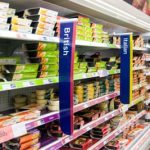You take the spreadable butter out of the fridge and put it on your bagel; you are sure it is more watery than it used to be. You pick up the bagel and some filling falls out – is the hole bigger? The coffee seems to have run out again, so you seriously consider a stiff drink but your gin seems to have less kick than it used to.
After you’ve eaten, you wash your hands – the bar doesn’t seem as big and there’s less lather – and then you squeeze out the last toothpaste from a tube you’re sure used to last longer. You wonder: is everything a bit worse than it used to be?
The answer, sadly, is yes. Shrinkflation and its sister skimpflation have hit many of the items in your shopping basket as rampant inflation in the cost of ingredients, energy and staff has forced manufacturers to take steps to keep prices down.
Having already put up the shelf prices of the goods, they have started reformulating recipes and shaving pack sizes. If you took your shopping trolley from two years ago and compared it with today’s, you would find you are paying more for less.
While many of us will have encountered this with the odd product, you may not have quite realised just how many of the things we buy have been shrunk, watered down or generally made not as good as before.
Mark Jones, a partner and food and drink expert at the law firm Gordons, says shrinkflation is not a new phenomenon, and that between 2012 and 2017 the Office for National Statistics found 2,529 products had been reduced in size.
“While we have not had updated shrinkflation data from the ONS since 2017, the trend has continued, with bread and cereals, personal care, meat and confectionery being the areas where the practice is most prevalent,” he says.
But, he adds, recipe changes are a new trend and are “almost impossible to spot, unless you pore over the ingredient quantities in the products you purchase, which consumers just don’t do”.
Guardian readers have noticed: when we asked you for examples, we were inundated with tales of products that don’t go as far as they used to, and packs that seem half-empty when you open them. From butter to dog food via the contents of your bathroom cabinet, it’s all changed.
In the UK, there are no rules saying retailers or manufacturers must highlight changes
Manufacturers and retailers say the reductions are designed to help consumers by allowing them to sell them at the same price.
But from our call-out, it is clear that two things particularly bother people: often they liked the original pack size, and it suited their purposes; and they feel that the changes are being made sneakily.
This is not only happening in the UK. In France, the supermarket chain Carrefour made headlines when it put signs on shelves alerting customers to shrinkflation in 26 products from big brands
Recently the French government announced that there would be new rules to force manufacturers to make changes more obvious to consumers. After campaigning by the European group Foodwatch, ministers in France said that from November, labels should highlight changes. The group is campaigning across Europe for more transparency around changes.
In the UK, consumer law says pack sizes must be indicated accurately and ingredients lists must be correct but there are no rules saying retailers or manufacturers must highlight changes.
Alex Lawrence, a senior strategic insight director at Circana, a consultancy that advises retailers and manufacturers on consumer behaviour, says that while shoppers may feel shrinkflation is “a bit underhand”, as long as they look at the unit price and compare, “they are not disadvantaged”.
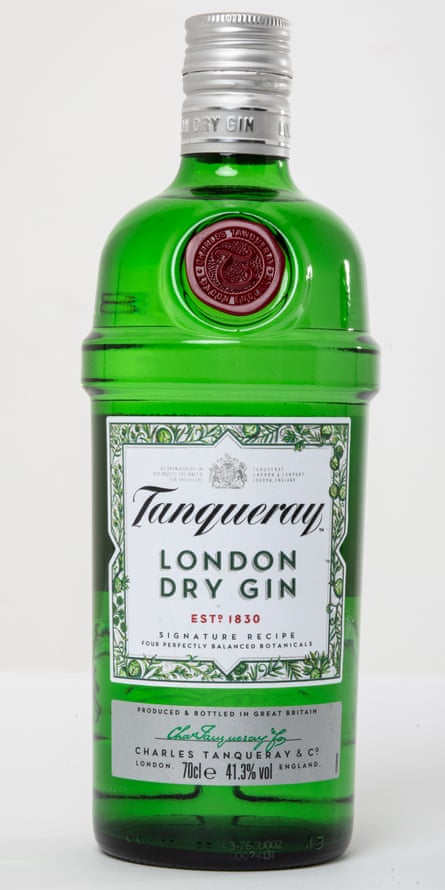 View image in fullscreenTanqueray London Dry Gin. Photograph: Antonio Olmos/The Observer
View image in fullscreenTanqueray London Dry Gin. Photograph: Antonio Olmos/The Observer
However, with skimpflation, he feels it is a different story and that manufacturers need to do more. “Shoppers have no way of knowing if the ingredients have changed without comparing old and new products, and, even then, they may have to go the product ingredients to work it out, which clearly isn’t fair on the shopper,” he says. “Where manufacturers make changes to product ingredients, they need to clearly call out the change as a new or reformulated product, with clear extra X% or less X% of ingredient Y.”
Here are just some of the examples you sent in, and others we spotted. There were so many that we could have gone on …
Alcoholic drinks
A reader who compared two bottles of Tanqueray London Dry Gin spotted a difference in the alcohol level: “Present bottle almost empty, 43.1% ABV [alcohol by volume]. New bottle just bought, 41.3% – very sneaky!”
The change, which happened in February, brought the alcohol volume in line with the rest of the Tanqueray range. By reducing the alcohol level, the maker, Diageo, also reduced the impact of new duties introduced on 1 August.
Another reader is a regular purchaser of Co-op’s Fairtrade South African red wine.
Last month he spotted that it had reduced in strength from 13% to 11%, with no change in price. “Except for that small detail, the label looks identical,” he said.
Under the new rules, wines with between 11.5% and 14.5% ABV will temporarily be taxed as if they are 12.5% in strength, which would mean an extra 44p a bottle.
A spokesperson for Co-op said the reduction was in response to the duty reforms. “We have lowered the ABV of this customer-favourited line to maintain the best possible value and price for our customers and members while ensuring quality wouldn’t be compromised,” they said.
Bagels
Pierre from London said: “I’ve noticed that the holes in the New York [Bakery Co] bagels are now consistently larger than before. The bagel diameter remains the same but the amount of bagel has gone down! Hazardous as lots of food now falls through the hole.”
When Guardian Money looked into (or should that be through?) the hole, it found that while each bagel used to weigh approximately 90g, it is now 85g. However, the company denied the hole story.
A spokesperson for New York Bakery Co said the weight had been reduced as a result of “ongoing inflationary costs”.
They added: “This reduction has been done in a way that ensures there has been no compromise on quality or taste for our customers. The reduction of weight would not impact the size of the much-loved bagel hole.”
 View image in fullscreenGuardian Money looked for the hole story about bagels. Photograph: Anjelika Gretskaia/Getty Images
View image in fullscreenGuardian Money looked for the hole story about bagels. Photograph: Anjelika Gretskaia/Getty Images
Soap
The Guardian reader Frazer spotted what has happened to bars of Simple soap: they used to be 125g each and have been reduced to 100g.
Reviews on Tesco’s website show shoppers are cross about the cut, and a change in the formulation. One customer posted: “Not only has it been significantly reduced in size, but after a short period of time, it struggles to make a lather. It has gone from being one of the best soaps to one of the worst.”
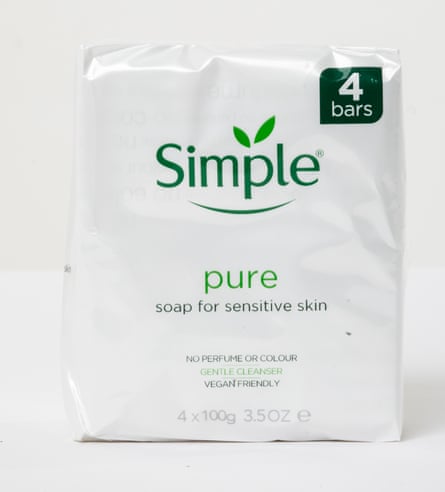 View image in fullscreenA packet of Simple soap. Photograph: Antonio Olmos/The Observer
View image in fullscreenA packet of Simple soap. Photograph: Antonio Olmos/The Observer
Close inspection of the ingredients shows that the second is now water, when previously that came third.
Simple Soap said the change was made “to help manage increased expenses without compromising on quality”, and that it kept an eye on prices to make sure it remained competitive.
It said the change in recipe was the result of move from tallow, an animal derived ingredient, to a vegetable-based soap suitable for vegans; with this change the order of the INCI altered slightly due to the chemistry involved.
It is not the only bar that has shrunk. Wright’s coal tar soap has also dropped from 125g to 100g. Shoppers also report a reduction in the fragrance, although there is no evidence of any recipe change in the ingredients.
Butter
There are two changes that have particularly upset consumers: pack size reductions and reformulations of spreadable versions.
Lurpak and Anchor used to be sold in 250g blocks but earlier this year they were cut to 200g. The 250g block was roughly equivalent to half a pound and was standard across the sector, so it is little wonder that shoppers have been caught out.
Jane from Cambridge told us she had to shrink a birthday cake after she realised she had bought a smaller pack, while Peter Ryan from Wiltshire said he bought three packs of Anchor and “noticed nothing unusual until [I] opened one a couple of days later. Then [I] realised it was 200g rather than 250g. External appearance had seemed identical to its predecessors. But this was just ‘thinner’. No explanation accompanied it. No doubt a future version will be advertised as ‘new, bigger size’.”
Fans of spreadable butter have been hit with shrinkage and, in some cases, reformulations.
David Pritlove from the West Midlands buys Anchor spreadable and said he had recently bought “a 400g impostor masquerading as 500g. Crucially, and critically for this to work, the container is almost identical (except for an unnoticeable – unless compared side by side – small difference in tub height). The pack’s main facet, the lid, is identical to the 500g tub.”
When Guardian Money looked at the small print, we realised that the ingredients had also changed, and that the volume of rapeseed oil has been reduced from 33% to 29%.
Arla, which owns Lurpak and Anchor, told us the new pack sizes “were driven by research with over 2,500 shoppers. Our research showed that the 200g and 400g pack size and price points were the most appealing to a greater proportion of shoppers. This reduction in size allowed us to offer a better value pack to shoppers.”
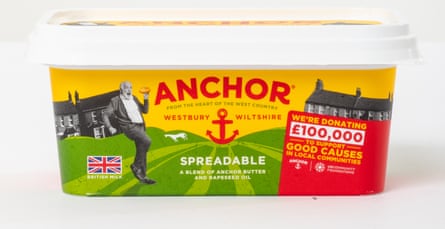 View image in fullscreenA tub of Anchor Spreadable. Photograph: Antonio Olmos/The Observer
View image in fullscreenA tub of Anchor Spreadable. Photograph: Antonio Olmos/The Observer
It said unit prices had fallen – this is true across the industry. The prices of feed, fertiliser and fuel have all edged downwards after huge increases after the coronavirus pandemic and around the start of the war in Ukraine.
On recipe changes, the spokesperson said: “We are always looking for ways to improve our recipes and have developed a new recipe that delivers our great Anchor buttery taste in every bite, but has reduced our overall fat content, calories and saturated fat content, while maintaining our overall butter content.”
Toothpaste
Retailers who used to sell 100ml packs of some toothpastes are now offering 75ml packs at the same price.
Helen York in East Lothian told us this was the case with the Colgate she bought at Aldi. She “only realised it had shrunk when I came to open it … I really hate getting proportionately more packaging, especially as the tube doesn’t recycle, and would rather pay more for the full size, but they are not to be found any more.”
 View image in fullscreenToothpaste changes have been noticed. Photograph: Alex1975K/Getty Images/iStockphoto
View image in fullscreenToothpaste changes have been noticed. Photograph: Alex1975K/Getty Images/iStockphoto
The same has happened at Tesco, where Colgate Triple Action toothpaste was 98p for 100ml but is now 98p for 75ml.
Guardian Money found several examples of Colgate variants that have been changed, as well as some Oral B products. Procter & Gamble, the maker of Oral B, declined to comment but said it does still make the larger pack sizes.
Coffee
Like butter, the standard size of a pack of ground coffee has a long history. It was sold by the pound, and the 227g pack was as close as you could get to half a pound.
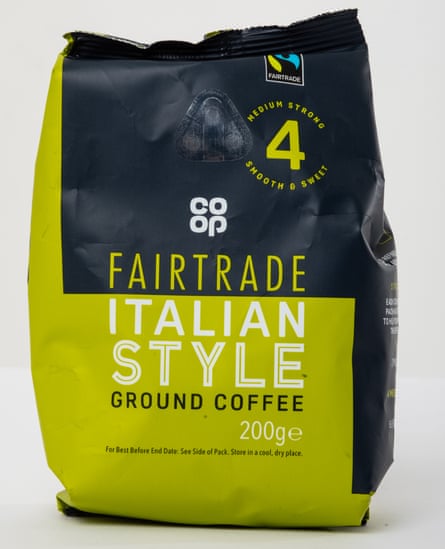 View image in fullscreenA bag of Italian Style Fairtrade Coffee. Photograph: Antonio Olmos/The Observer
View image in fullscreenA bag of Italian Style Fairtrade Coffee. Photograph: Antonio Olmos/The Observer
However, in recent years, new entrants to the supermarkets such as Costa launched 200g bags, and now the rest of the shelf seems to be following.
A reader spotted some Co-op coffees have been reduced, and Guardian Money found the Fairtrade specialistCafédirect has started to sell smaller bags.
The changes follow a rise in the price of coffee on the wholesale market and increases in labour costs.
A spokesperson for Co-op said: “Like all retailers, we have seen high increases in the cost price of coffee this year. By very slightly reducing the weight of our ground coffee by a few grams and absorbing the remaining costs ourselves, we’ve managed to maintain the retail price and not pass this cost increase on to customers, and in fact, Co-op members benefit from an additional 30p member-only price reduction.”
Cafédirect said it had been hit by higher operational costs but was not shrinkflating products – it said prices had been cut, too. “To make our price more accessible, we’ve reduced our pack size, passing all the savings back to the customer,” said its chief executive, John Steel. “These packs are more accessible at a lower price, so more people can enjoy our delicious coffee for an even bigger impact on farmers’ incomes.”
Yoghurts
 View image in fullscreenA tub of Yeo Valley natural yoghurt. Photograph: Antonio Olmos/The Observer
View image in fullscreenA tub of Yeo Valley natural yoghurt. Photograph: Antonio Olmos/The Observer
If you buy big tubs of yoghurt, the chances are you are now getting smaller tubs than you did 18 months ago. Manufacturers and retailers have shrunk the amount in the packs, and it is typically impossible to tell when you pick up the tub – particularly the mid-sized versions that were 500g and are now 450g.
Changes at Yeo Valley are typical: it did package natural yoghurt in 1kg, 500g, 150g and 4x120g packs but now only the 150g remains unchanged. The others are down to 950g, 450g and 4x110g respectively.
A spokesperson said: “It’s well documented that there is an unprecedented rise in costs and inflation across the food and farming system. In order to protect our customers as much as possible from this cost rise, 12 months ago we reduced the weight on a limited number of our yoghurt products. We made this difficult decision to ensure we can continue to provide high-quality, organic products that remain affordable to our customers.”
Pet food
Whiskas cost-cutting caught out cat lovers in the spring when smaller packs and new recipes left their furry friends yowling for more, but dog owners have not been immune to shrinkflation.
 View image in fullscreenShrinkflation has even extended to pet food. Photograph: Sally Anscombe/Getty Images
View image in fullscreenShrinkflation has even extended to pet food. Photograph: Sally Anscombe/Getty Images
A reader who works in a supermarket alerted us to changes in Harringtons dog food. Those catering for canines could previously choose between packs weighing 15kg, 5kg and 2kg – but now the options are 12kg, 4kg and 1.7kg.
A spokesperson for Harringtons explained the changes: “We have done our utmost to absorb costs in the face of spiralling inflation, and ultimately had to consider how to continue delivering this, while maintaining a sustainable business. Faced with having to pass very significant price increases to our loyal customers … we chose to reorganise our range and maintain our recommended retail price to ensure shoppers could still access quality pet nutrition within their weekly budget.”


